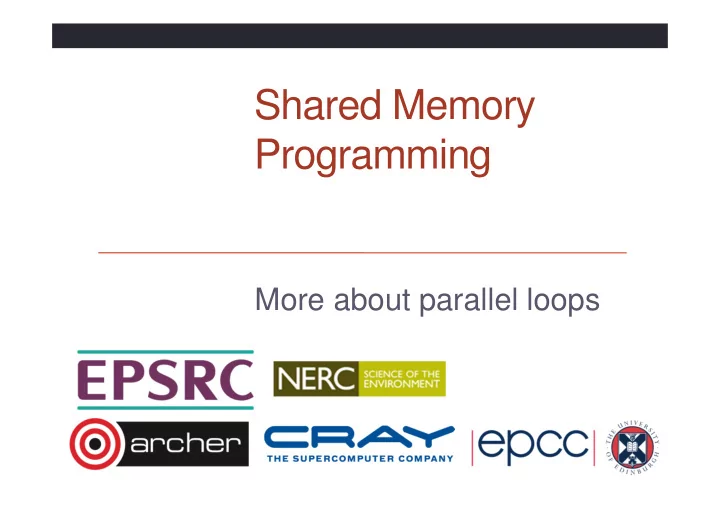

Shared Memory Programming More about parallel loops
LASTPRIVATE clause • Sometimes need the value a private variable would have had on exit from loop (normally undefined). Syntax: Fortran: LASTPRIVATE(list) C/C++: lastprivate(list) • Also applies to sections directive (variable has value assigned to it in the last section.)
LASTPRIVATE clause (cont) Example: !$OMP PARALLEL !$OMP DO LASTPRIVATE(i) do i=1,func(l,m,n) d(i)=d(i)+e*f(i) end do ix = i-1 . . . !$OMP END PARALLEL
SCHEDULE clause • The SCHEDULE clause gives a variety of options for specifying which loops iterations are executed by which thread. • Syntax: Fortran: SCHEDULE ( kind[, chunksize] ) C/C++: schedule ( kind[, chunksize] ) where kind is one of STATIC, DYNAMIC, GUIDED or RUNTIME and chunksize is an integer expression with positive value. • E.g. !$OMP DO SCHEDULE(DYNAMIC,4)
STATIC schedule • With no chunksize specified, the iteration space is divided into (approximately) equal chunks, and one chunk is assigned to each thread in order ( block schedule). • If chunksize is specified, the iteration space is divided into chunks, each of chunksize iterations, and the chunks are assigned cyclically to each thread in order ( block cyclic schedule)
STATIC schedule
DYNAMIC schedule • DYNAMIC schedule divides the iteration space up into chunks of size chunksize , and assigns them to threads on a first-come-first-served basis. • i.e. as a thread finish a chunk, it is assigned the next chunk in the list. • When no chunksize is specified, it defaults to 1.
GUIDED schedule • GUIDED schedule is similar to DYNAMIC, but the chunks start off large and get smaller exponentially. • The size of the next chunk is proportional to the number of remaining iterations divided by the number of threads. • The chunksize specifies the minimum size of the chunks. • When no chunksize is specified it defaults to 1.
DYNAMIC and GUIDED schedules
RUNTIME schedule • The RUNTIME schedule defers the choice of schedule to run time, when it is determined by the value of the environment variable OMP_SCHEDULE . • e.g. export OMP_SCHEDULE=”guided,4” • It is illegal to specify a chunksize in the code with the RUNTIME schedule.
Choosing a schedule When to use which schedule? • STATIC best for load balanced loops - least overhead. • STATIC, n good for loops with mild or smooth load imbalance, but can induce overheads. • DYNAMIC useful if iterations have widely varying loads, but ruins data locality. • GUIDED often less expensive than DYNAMIC, but beware of loops where the first iterations are the most expensive! • Use RUNTIME for convenient experimentation.
ORDERED directive • Can specify code within a loop which must be done in the order it would be done if executed sequentially. • Syntax: Fortran: !$OMP ORDERED block !$OMP END ORDERED C/C++: #pragma omp ordered structured block • Can only appear inside a DO/FOR directive which has the ORDERED clause specified. • Main use is in testing to force ordering of output
ORDERED directive (cont) Example: !$OMP PARALLEL DO ORDERED do j=1,n . . . !$OMP ORDERED write(*,*) j,count(j) !$OMP END ORDERED . . . end do !$OMP END PARALLEL DO
Practical session Finding Goldbach pairs • Aim: experiment with loop schedules. • The Goldbach conjecture says that every even number greater than 2 is the sum of 2 primes. • For the first 4000 even numbers, find all pairs of primes which sum to the even number. • Computational cost rises as n 3/2 , giving an unbalanced load • Parallelise with a DO directive, and experiment with different schedule options.
Recommend
More recommend